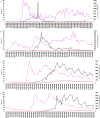Interest in dentistry in early months of the COVID-19 global pandemic: A Google Trends approach
- PMID: 35166022
- PMCID: PMC9111387
- DOI: 10.1111/hir.12421
Interest in dentistry in early months of the COVID-19 global pandemic: A Google Trends approach
Abstract
Background: In early the COVID-19 pandemic, routine dental treatments have been delayed due to the risk of disease transmission. This delay may lead public to search for information on the Internet for a solution.
Objectives: This study aims to evaluate the public interest in dentistry in the early months of the COVID-19 global pandemic in the selected countries.
Methods: The daily numbers of new COVID-19 cases were recorded for China, South Korea, Italy, Germany, Russia, Ukraine and Turkey. For these countries, Internet search interest of the keyword 'dentistry', 'coronavirus', 'COVID-19', 'SARS-CoV-2' and 'pandemic' in the early months of the COVID-19 pandemic was evaluated by using Google Trends data.
Results: In most countries included the public Internet search interest in 'dentistry+coronavirus+COVID-19+SARS-CoV-2+pandemic' peaked prior to the peak of new COVID-19 cases. While a statistically significant positive correlation was observed between the number of new cases and Google Trends data in China, South Korea, Italy and Germany, a statistically significant negative correlation was observed in Turkey.
Conclusion: The peak public interest in dentistry has been prior to the peak of COVID-19 new cases in most countries. The use of Internet data can provide useful information about pandemics and many other diseases.
Keywords: dental health; internet; pandemic; quantitative; research.
© 2022 Health Libraries Group.
Conflict of interest statement
None.
Figures


Similar articles
-
Ocular-symptoms-related Google Search Trends during the COVID-19 Pandemic in Europe.Int Ophthalmol. 2021 Jun;41(6):2213-2223. doi: 10.1007/s10792-021-01782-5. Epub 2021 Mar 16. Int Ophthalmol. 2021. PMID: 33725271 Free PMC article.
-
Association of the COVID-19 pandemic with Internet Search Volumes: A Google TrendsTM Analysis.Int J Infect Dis. 2020 Jun;95:192-197. doi: 10.1016/j.ijid.2020.04.033. Epub 2020 Apr 17. Int J Infect Dis. 2020. PMID: 32305520 Free PMC article.
-
Public Interest in Immunity and the Justification for Intervention in the Early Stages of the COVID-19 Pandemic: Analysis of Google Trends Data.J Med Internet Res. 2021 Jun 18;23(6):e26368. doi: 10.2196/26368. J Med Internet Res. 2021. PMID: 34038375 Free PMC article.
-
Impact of the pandemic and its containment measures in Europe upon aspects of affective impairments: a Google Trends informetrics study.Psychol Med. 2023 Dec;53(16):7685-7697. doi: 10.1017/S0033291723001563. Epub 2023 Jun 26. Psychol Med. 2023. PMID: 37357891 Free PMC article. Review.
-
Forecasting and Surveillance of COVID-19 Spread Using Google Trends: Literature Review.Int J Environ Res Public Health. 2022 Sep 29;19(19):12394. doi: 10.3390/ijerph191912394. Int J Environ Res Public Health. 2022. PMID: 36231693 Free PMC article. Review.
References
-
- Ayyoubzadeh, S. M. , Ayyoubzadeh, S. M. , Zahedi, H. , Ahmadi, M. , & Kalhori, S. R. N. (2020). Predicting COVID‐19 incidence through analysis of Google Trends data in Iran: Data mining and deep learning pilot study. JMIR Public Health and Surveillance, 6(2), e18828. 10.2196/18828 - DOI - PMC - PubMed
MeSH terms
LinkOut - more resources
Full Text Sources
Medical
Miscellaneous

